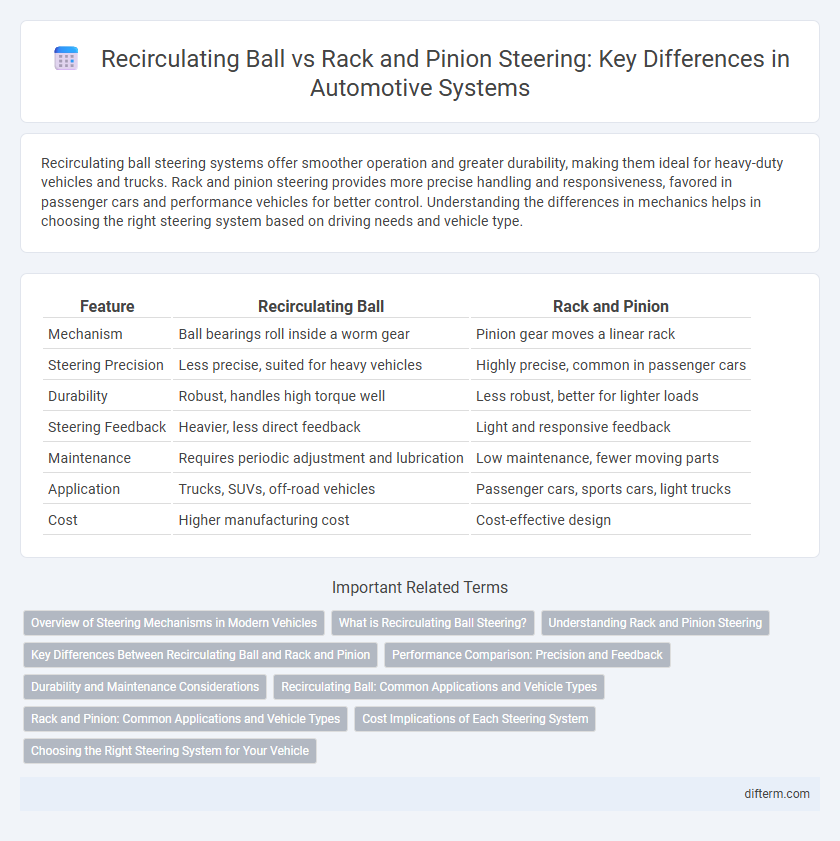Recirculating ball steering systems offer smoother operation and greater durability, making them ideal for heavy-duty vehicles and trucks. Rack and pinion steering provides more precise handling and responsiveness, favored in passenger cars and performance vehicles for better control. Understanding the differences in mechanics helps in choosing the right steering system based on driving needs and vehicle type.
Table of Comparison
| Feature | Recirculating Ball | Rack and Pinion |
|---|---|---|
| Mechanism | Ball bearings roll inside a worm gear | Pinion gear moves a linear rack |
| Steering Precision | Less precise, suited for heavy vehicles | Highly precise, common in passenger cars |
| Durability | Robust, handles high torque well | Less robust, better for lighter loads |
| Steering Feedback | Heavier, less direct feedback | Light and responsive feedback |
| Maintenance | Requires periodic adjustment and lubrication | Low maintenance, fewer moving parts |
| Application | Trucks, SUVs, off-road vehicles | Passenger cars, sports cars, light trucks |
| Cost | Higher manufacturing cost | Cost-effective design |
Overview of Steering Mechanisms in Modern Vehicles
Recirculating ball and rack and pinion are two primary steering mechanisms used in modern vehicles, each offering distinct advantages. Recirculating ball systems utilize a series of ball bearings to reduce friction in the steering gear, providing durability and smoother steering in heavy-duty applications like trucks and SUVs. Rack and pinion steering, common in passenger cars, converts rotational motion of the steering wheel directly to lateral movement, delivering precise handling and responsive control essential for performance and efficiency.
What is Recirculating Ball Steering?
Recirculating ball steering is a type of steering mechanism commonly used in older and heavy-duty vehicles, featuring a worm gear inside a block with ball bearings that recirculate to reduce friction and wear. This system offers enhanced durability and easier handling for trucks and large vehicles by distributing the steering load more evenly across the components. Compared to rack and pinion steering, recirculating ball provides smoother operation under heavy loads but with less precise steering response.
Understanding Rack and Pinion Steering
Rack and pinion steering offers precise control by converting rotational motion of the steering wheel into linear motion with a direct gear engagement, enhancing responsiveness and feedback. This system is lighter and more compact compared to the recirculating ball design, resulting in improved fuel efficiency and easier maintenance. Commonly used in modern passenger vehicles, rack and pinion steering provides better handling and a more direct road feel, essential for agile urban and performance driving.
Key Differences Between Recirculating Ball and Rack and Pinion
Recirculating ball steering systems feature a worm gear mechanism with ball bearings that reduce friction, providing smoother steering and greater durability, typically used in heavy-duty vehicles and trucks. Rack and pinion steering employs a direct gear connection that converts rotational motion into linear motion, offering more precise handling and responsiveness favored in passenger cars. Key differences include the complexity and weight, with recirculating ball being bulkier and more complex, while rack and pinion is lighter, simpler, and delivers faster steering feedback.
Performance Comparison: Precision and Feedback
Rack and pinion steering systems offer superior precision and more responsive feedback compared to recirculating ball mechanisms, enabling better control and handling in modern vehicles. Recirculating ball systems provide smoother operation and greater durability but sacrifice some tactile road feel and accuracy, which can impact performance in high-speed or sporty driving. Engineers often favor rack and pinion for performance-oriented cars due to its direct steering response and enhanced driver engagement.
Durability and Maintenance Considerations
Recirculating ball steering systems offer enhanced durability due to their robust design and ability to handle heavy loads, making them ideal for trucks and off-road vehicles. Rack and pinion systems require less maintenance with fewer moving parts but may wear out faster under heavy use, especially in high-performance or frequently driven vehicles. Choosing between the two depends on balancing long-term durability needs against maintenance frequency and driving conditions.
Recirculating Ball: Common Applications and Vehicle Types
Recirculating ball steering systems are commonly found in heavy-duty trucks, SUVs, and off-road vehicles due to their durability and ability to handle high steering loads. This system excels in applications requiring greater mechanical advantage and reduced steering effort on rugged terrains. Its robust design makes it ideal for commercial vehicles and larger passenger vehicles where precise control under heavy stress is essential.
Rack and Pinion: Common Applications and Vehicle Types
Rack and pinion steering systems are predominantly used in passenger cars and light trucks due to their precise control and compact design. This mechanism offers responsive handling, making it ideal for smaller vehicles where agility and steering feedback are critical. Popular applications include sports cars, sedans, and crossover SUVs, where direct steering input and efficiency are prioritized.
Cost Implications of Each Steering System
Recirculating ball steering systems generally incur higher manufacturing and maintenance costs due to their complex design and multiple moving parts. Rack and pinion steering is more cost-effective, offering simpler construction and lower production expenses, making it the preferred choice for most modern passenger vehicles. While recirculating ball systems provide durability for heavier vehicles, their cost implications limit widespread adoption in standard automotive applications.
Choosing the Right Steering System for Your Vehicle
Choosing the right steering system depends on vehicle type, driving conditions, and desired handling characteristics. Recirculating ball steering offers durability and smooth operation in heavy-duty trucks and off-road vehicles, while rack and pinion steering provides precise control and responsiveness preferred in passenger cars and sports vehicles. Evaluating factors such as steering feedback, maintenance, and application-specific performance is essential for optimal vehicle handling and safety.
recirculating ball vs rack and pinion Infographic

 difterm.com
difterm.com